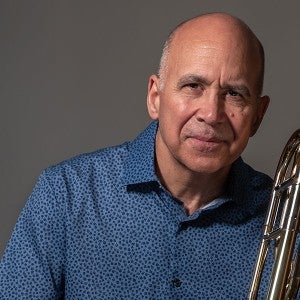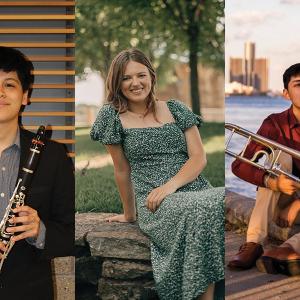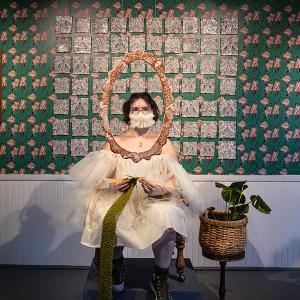Nicole Abissi: Flexibility and accessibility
Freelance trombonist Nicole Abissi’s unexpected career path has led her to motherhood, musicianship, and entrepreneurship.
Like many young trombonists, Nicole Abissi (IAC 99-01, IAA 01-03) struggled to reach her instrument’s farthest positions.
“I tried all the tricks, but I was still about an inch too short in arm or finger,” she said.
Fortunately for Abissi, her parents were able to buy her a trombone with an F-attachment, eliminating the need for long reaches. But as her professional teaching and playing career unfolded, Abissi realized purchasing a new instrument is not a feasible solution for every musical and financial situation.
Inspired by the need she saw, Abissi developed Extendabone, a small plastic device that enables players to easily reach the trombone’s sixth and seventh positions. Her patent-pending invention—which is made in the United States using environmentally friendly processes and packaged in biodegradable materials—is now available to musicians around the world.
In addition to managing her growing business, Abissi maintains an active career as a performer and teacher. She currently teaches trombone at Montclair State University and performs on a freelance basis with diverse ensembles including New York City-based orchestras, Broadway pit ensembles, chamber groups, and more.
“The most interesting thing for me is how many twists and turns my career has taken,” Abissi said. “I’m grateful that I’ve been open to the way things can change and been flexible to adapt.”
We caught up with Abissi to learn more about her Interlochen journey, freelancing experience, and barrier-breaking invention.
How did you start playing trombone?
I attended an elementary school in Long Island, where they started string orchestra in fourth grade and band in fifth grade. As a younger student, I would have to sit in assembly and watch the older kids play. I knew that I liked the sound of male voices; I grew up listening to Broadway, and the male songs were always the ones that I liked best. The trombone was the most unique instrument in the band, since it has no buttons, and it also gave me an opportunity to sing like these voices that I loved. It was the perfect combination.
What are some of your fondest memories of Interlochen? What particular moments stand out?
I went to Camp first. I actually met [Philadelphia Orchestra Principal Tuba] Carolyn Jantsch (IAC 94-96, 98-99, IAA 99-02, IAC St 02, AS Fac 05) that summer—we were in band together and had the same supervised practice hour. Interlochen opened a million doors for me. It transformed my awareness of what it was to play an instrument. I was there for four weeks, and it changed my whole life. Camp really opened my eyes to an entire world, an entire life that was possible as a musician.
At the Academy, Mr. Riccobono became like an extra uncle or godfather to me. I don't think anything that I’ve done in my career would have been possible without him and what he taught me.
The education I got from teachers outside of music was unbelievable as well. Now that I’m a mother, I’ve been thinking a lot about the academics at the Academy. It’s the kind of education that I want my kids to have: an education that teaches them to think for themselves.
You recently invented a device to help young trombonists reach the trombone’s furthest positions. How did that invention come about?
As a trombonist, you don’t have to play in seventh position most of the time if you have a valve. I was lucky: I had a Bach 36 by the time I was in sixth grade, so I didn’t need to try. But when I was at Juilliard, I encountered one piece—the Pulcinella solo by Stravinsky—that requires you to play in seventh position. This was the first time that something came up that I was physically incapable of doing. I tried all the tricks, but I was still about an inch too short in arm or finger. My teacher, Joe Alessi, said “you can’t be the first. There has to be something on the market to solve this problem.” He was right: there was. It was cruddy and metal and it scratched up the lacquer, but it existed.
A few years ago, somebody was asking about this problem on a trombone forum and I went to search for a link to the product, and it was not in stock anywhere. The company went bankrupt, got bought out, and stopped production. I said to myself, “Why don't I come up with something better?”
I did some research and found out there was no patent on the device. I worked with computer aided design to create a model, and we 3D printed the prototypes. I went to Steve Dillon, who owns one of the largest music stores on the East Coast, and pitched him the idea. He’s good friends with Steven Greenall (who invented the pBone) and set me up with him. Steven became my mentor and helped me think about how to make my prototype better.
The Extendabone is an accessibility thing, both physically and economically. There are lots of school systems and families that can’t afford to buy an instrument with a valve. Some kids are not even started on the trombone because parents and teachers think it’s too big for them. Doc Severinson himself has said that he wanted to play trombone, but his dad thought he was too small. Think of how many others have been told that! Students don’t necessarily grow into being able to reach. I’ve seen high schoolers—both boys and girls—who can’t reach seventh position. There are even professionals who mess up their embouchure, neck, or arm trying to reach seventh position!
As a freelancer, you’re frequently called to work a variety of gigs, from orchestral subbing to Broadway pits. How do you prepare mentally and musically for such diverse assignments?
It’s challenging because you never know what your next gig could be, but that also makes it fun.
Listening to the music is the best way. For example, West Side Story was the last musical I played. I’ve played it with an orchestra before, but when it was time to play with the pit, they were playing it the way a big band would. I had to study and adjust. That’s what you do for everything.
What’s your advice for young artists on marketing themselves and finding jobs?
One of the things that I’ve tried to tell my students in college is to take advantage of work-study opportunities. Once I had to transition from a full-time orchestral job to freelancing, I noticed the opportunities that I had maybe missed at Juilliard. I worked in the orchestra library, and I’m a highly trained orchestral librarian, but I don't have any experience that qualifies me to work in an office, even at a nonprofit. But anyone who worked in the registrar’s office or admission has office experience and learns how to use software. They can easily find a side hustle that will keep them in steady paychecks while freelancing. Think about what else you’re interested in, and try to get jobs in that field. Everybody does work-study anyway—why not get real-world experience while doing it?
It’s important to use the opportunities that are around you. As musicians, we often do these community engagement things at hospitals or schools. I gave a master class on freelancing at New England Conservatory last year, and spoke with a trombone quartet. I told them to name their quartet, put together a press kit, refine these programs, and go out and sell them. Use the school gigs as opportunities to refine what you're doing and get as good as you possibly can at speaking to audiences. Then you have a product that you can sell.
When it comes to marketing your brand, I’m still a student of that. I’ve built websites—I just revamped mine, actually—but what I’m really good at is being myself. I like to write about teaching and practicing and share my authentic self on social media.





